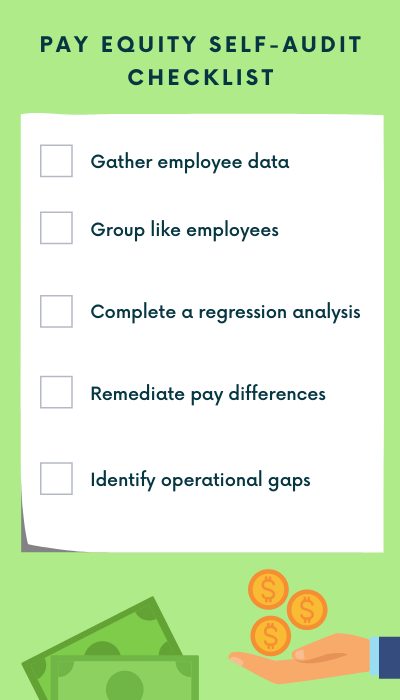This pay equity self-audit checklist will help you correct pay disparities
 Our society demands equity now more than ever, and pay is at the top of the list for many. Many states are passing more extensive pay equity laws, and some are filing lawsuits against companies that violate these laws.
Our society demands equity now more than ever, and pay is at the top of the list for many. Many states are passing more extensive pay equity laws, and some are filing lawsuits against companies that violate these laws.
While federal pay equity laws have been in place for decades, state and local pay laws are now being expanded. This puts companies’ pay practices under a microscope as we work to close the gender and ethnic pay gap in our country.
With this in mind, conducting a pay equity self-audit should undoubtedly be on your 2021 to-do list. After all, you don’t want to discover any pay disparities through litigation.
What is pay equity?
As with other forms of equity, pay equity aims to end discriminatory practices in pay disproportionately based on sex and race. Women and people of color are typically hit the hardest.
The purpose of a pay audit
The purpose of a pay audit is to provide you with the information you need to identify pay disparities within your organization. Additionally, it helps you discover opportunities to offer more equitable pay across the board.
There are legitimate reasons for an organization’s pay differences, such as job experience, education level, and seniority. However, a pay audit will help you identify when there are no legitimate reasons for the pay discrepancy.
What you discover will determine how you fix it. If the pay inequities are due to non-legitimate reasons such as gender or race, steps should be taken. In addition to determining how to prevent this in the future, you must also correct it01 as soon as possible.
Pay equity self-audit checklist
While companies are hesitant to conduct a pay audit for fear of what they might uncover, they should see it as an opportunity for improvement. The worst-case scenario is you’ll uncover discrepancies that you need to change before revealing these inequities. This could prevent future lawsuits against your company. The best-case scenario is you’ll realize you have no pay inequities and can continue as you are.
Either way, conducting a self-pay equity audit will uncover knowledge about your pay practices.
Follow this checklist as you complete your audit to ensure you’re hitting the most important steps along the way.
Gather employee data
Gather all relevant employee information, including demographics (age, gender, race, etc.), length of employment, performance reviews, and job classification. This can be time-consuming, especially if you do not already have this information document or if the information is in different places. Still, having accurate and complete information is crucial to the success of the pay equity self-audit.
Group like employees
Categorize employees into “like jobs” groups requiring equal skill, responsibility, effort, and working conditions.
Complete a regression analysis
Your regression analysis accounts for pay differences amongst employees in the same category based on legitimate factors. During this phase, you will work to discover discriminatory pay practices based on things like gender, race, and age-based outliers. State laws vary, so review your state’s laws regarding what’s considered a legitimate cause for a pay difference.
You might identify outliers the first time you run your regression analysis, but it doesn’t mean you’re done. You might need to redo this as you refine your employee groupings.
Remediate pay differences
If you uncover discriminatory pay practices during your pay equity self-audit, you should determine how to remediate the situation. Typically you should offer a pay increase to those who are eligible based on your findings. You can choose to increase their pay incrementally until it hits the target rate or offer the increase all at once based on your budget.
It’s important to note that you can’t decrease the pay of employees paid more to close the pay gap. Your responsibility is to raise the pay rate of those who are underpaid.
Identify operational gaps
Finally, you will identify operational gaps that caused the salary discrepancies within your company. Once these are uncovered, the human resources department, with the legal team’s guidance, should monitor hiring, promotion, and compensation to ensure you’re meeting pay equity requirements.
You must have conversations with those responsible for hiring so they understand the audit findings, what went wrong, and how to ensure circumstances improve moving forward.
Additional pay equity self-audit tips
Your pay equity self-audit is personal to your organization based on your current needs. Following the checklist outlined above will help you complete your audit successfully, but here are some additional tips to keep in mind.
- This isn’t a one-time act. You should plan to complete a small audit annually to ensure you haven’t veered off track. Do a more comprehensive audit every few years.
- Act under attorney-client privilege throughout the process. Doing so is helpful so you can openly dive deep into your data without fear of your findings being used against you in potential future litigation.
- Take notes throughout the process. Since litigation often happens years after an employee has been with the company, you want to have notes within the organization. You can reference these later for accurate information, whether staff changes or memories fade regarding the audit’s specifics.
Additional Resource: See more on current pay equity laws that could impact your organization.






